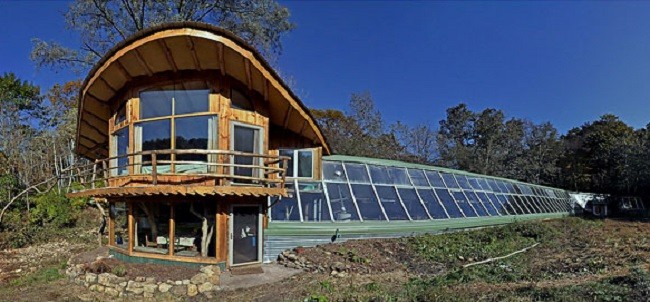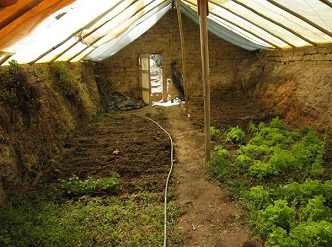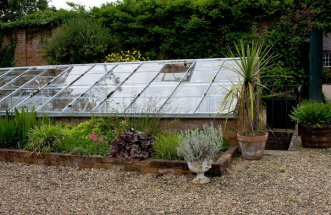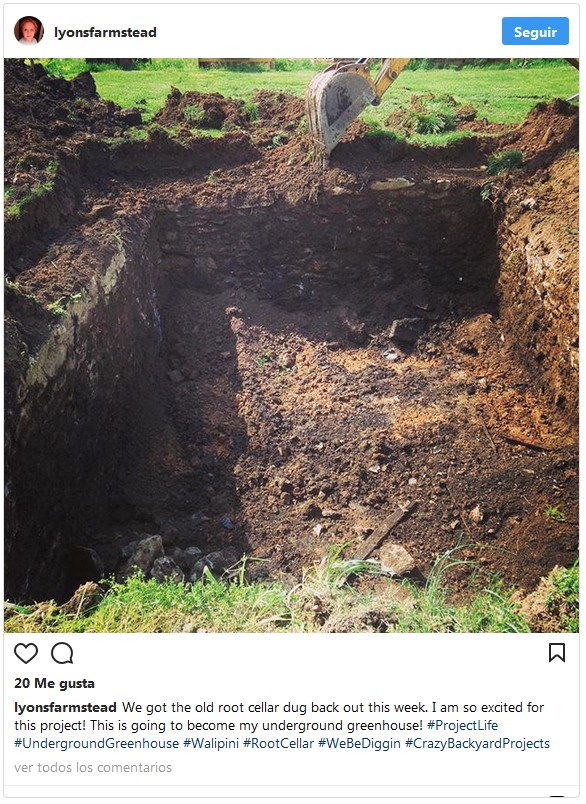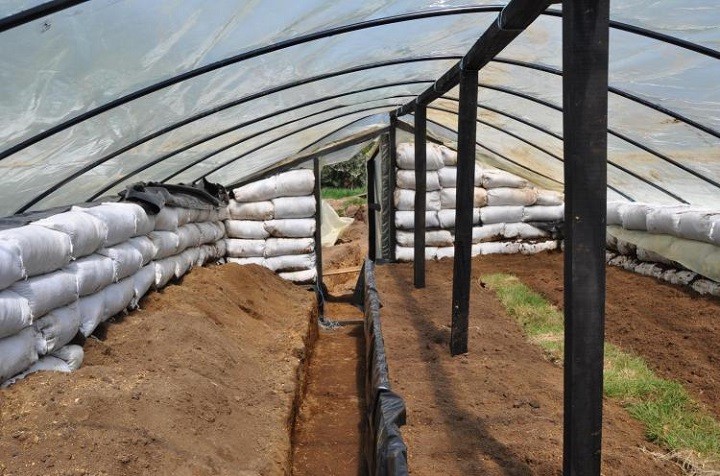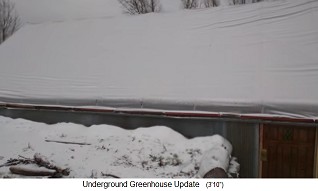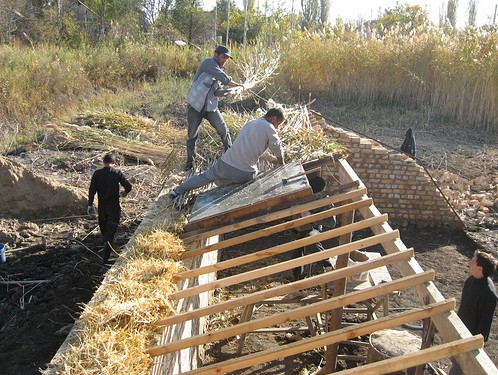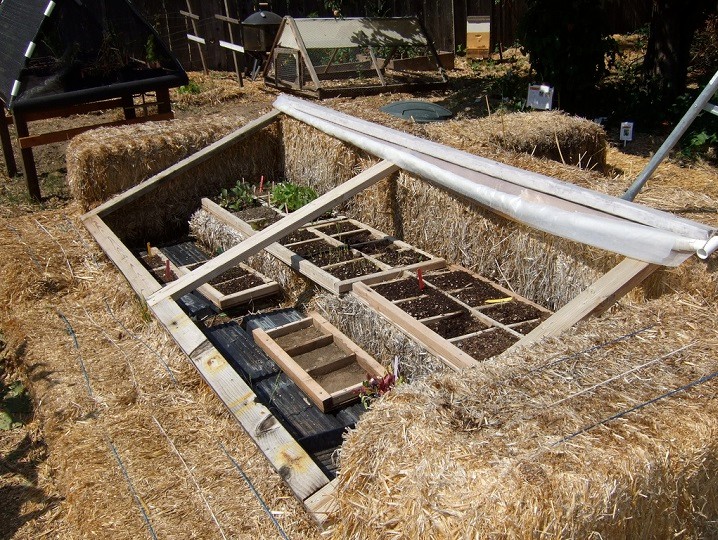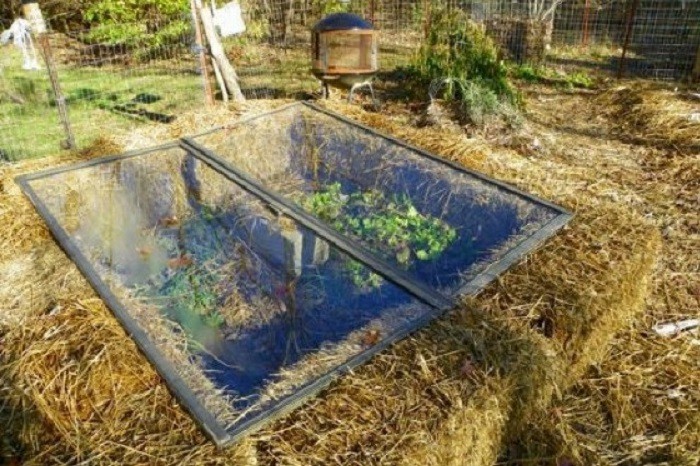D - ESP - Sve -
"Walipini" - the pit greenhouse (underground greenhouse) for ALL SEASONS
With Walipini, EVERY COUNTRY can run its own agriculture ALL YEAR THROUGH.
NO pesticides - NO machines - NO long transports - NO overuse of hot regions' water resources for plantations any more etc.
MINIMAL costs - Mother Earth gives it to you!
presented by Michael Palomino (2018)
| Share: |
Facebook |
|
Twitter
|
|
|
|
Literature
-- James McCullagh: The Solar Greenhouse Book - edition: Rodale press
-- Mike Oehlers: The Earth Sheltered Solar Greenhouse Book
With Walipini half underground pit greenhouse, EVERY COUNTRY can run its own agriculture ALL YEAR THROUGH. -- The tricks for pit greenhouses -- NO pesticides - NO machines - NO long transports - NO overuse of hot regions' water resources for plantations any more etc. - MINIMAL costs - Mother Earth gives it to you! -- The pit greenhouse (underground greenhouse) "Walipini" -- 20-02-2013: Half-underground pit buildings: benefits of thermal inertia -- Some pit greenhouses around the world -- 1) Walipini from LaPaz, Bolivia -- 2) Walipini: Pit greenhouse made of stone walls of native stones -- 3) Walipini: A pit greenhouse in Mongolia -- 4) Walipini: Pit greenhouse with good insulation -- 5) Walipini: A garden greenhouse is currently being installed here. -- 6) Walipini: Underground greenhouse on a mountain slope in Tennessee -- 7) Walipini in a hard soil like sandstone, Texas -- 8) Walipini: Lowered pit greenhouse with earth bags in Patagonia, Argentina -- 9) Walipini: A pit greenhouse in an embankment - Bolivia -- 10) Walipini: An old rocket silo is turned into a pit greenhouse - Nebraska ("USA") -- 11) Walipini: A pit greenhouse with a drainage ditch -- 12) Walipini: Pit greenhouse on the mountainside -- 13) Walipini: Building a stable roof with a transparent corrugated roof -- 14) Walipini: Pit greenhouse with old window construction and plastic sheeting as a roof -- 15) Walipini: Half-underground greenhouse (pit greenhouse) excavated by hand, New Mexico -- 16) Walipini: The pit greenhouse of Simple Ground ("USA") -- 17) Walipini: Pit greenhouse on a hill in Ladakh, North India -- 18. Tube pit greenhouse from Roald Gundersen, Wisconsin ("USA") -- 19. Attached pit greenhouses with a stone wall as back wall -- 20a. Attached pit greenhouse with arched roof in a half-U by Rob Stout, Embudo, New Mexico ("USA") -- 20b. Attached pit greenhouse with glass roof and glass walls -- 21 Walipini: Pit greenhouse on a slope with cold sink -- 22. Straw bale greenhouses -- 23. Pit greenhouse in Bozeman (Montana, Canada) with cold trench and water barrel heating -- More links about pit greenhouses -- Best books on how to build an underground greenhouses -- More underground greenhouse resources -- Underground greenhouse video -- Nov. 4, 2015: Building a cold-resistant underground greenhouse
High Andes 25.7.2017: Agriculture in high mountains in half underground greenhouses (pit greenhouses) "Walipini"
www.facebook.com/gmofreeusa
www.gmofreeusa.org
Bolivia in the high Andes at 4000m above sea level: The Walipini is a semi-underground pit greenhouse with geothermal heat, where it never gets below 0 degrees [1]
The tricks for pit greenhouses
1. Stable micro climate in earth pit houses because earth layer needs months for reacting: Deep earth is always moderately warm in winter times and moderately cold in summer times because of thermal inertia: the earth layer needs several months to adapt the temperature outside.
2. 1,2m: The minimum depth of a pit house in the earth is 1,2m.
3. Wall materials: Wall material can be earth, earth bricks, natural stones, earth bags, water barrels.
4. The walls are a heating battery: The walls are storing the heat and give the heat during the night so it's never too cold during the night, also earth walls are like a battery and give off the heat at night.
5. Heating from 5 sides: 4 walls and the floor are heating during the night: The heating in the night comes from 5 warm sides: 4 warm walls and from the warm ground - in a normal greenhouse only 1 side is warm: the ground
6. Heating with rain water barrels installed at the back wall: this is the best method of heating in a Walipini greenhouse because water stores the warmth most and is radiating this warmth most during the night - the barrels just need their space.
7. Watering plants with rain water in the water barrels: Rain water can be collected in the water barrels. Whoever uses permaculture layering in raised beds with wood, leaves and compost never has to water anything.
8. Watering the plants with the rain water: When the water barrels are full another water tank can be filled for watering the plants with living water.
9. 1m over groundwater level: Pit houses have to be installed at least 1m above the groundwater level or there can be a water desaster
10. Window side to the sun: The window side always has to be installed to the sunny side: In the northern hemisphere the windows are installed to the south, and the northern wall is storing most of the heat. In the southern hemisphere the windows are oriented to the north and the southern wall is storing most of the heat.
11. Inclination of the window side: The inclination of the principal window side is optimal when the angle to the sun during the winter solstice is 90º - or the window side is formed round in form of a half U well adapted to any angle of the sun
12. Little windows for ventilation: The little windows are installed within the window side
13. Window materials / transparent roof materials: Windows are made of glass or plexiglas (four-walled polycarbonate sheets) with a thickness of 7/8". The Plexiglas is then bendable to form half a U.
14. Plastic film is toxic because the weathering provokes that constantly microplastic is emitted into the air and the air is contaminated and poisoned.
15. The tube pit house: the longer a pit greenhouse is (a tube pit greenhouse), the warmer it will be and the more stable the temperature will be at night. A pit greenhouse must not have any holes at night to keep the cold air outside.
16a. Roofs (transparent): may be in form of a V (glass, plexiglass) or U (plexiglass). Plastic film (PVC) is TOXIC, is emitting constantly microplastic into the air contaminating everything.
16b. Roofs (hard material) can be a normal roof combined with a window front to the sunny side, or the roof can be a slope of a mountain combined with a window front to the sunny side.
17. Waterproff, dreinage, ventilation: All has to be waterproof, no holes in the construction, there has to be dreinage, and for summer times ventilation respectively open windows have to be possible
18. Hail damage can be awoided with chicken wire: One can span a glass roof or plexiglass roof with a chicken wire so big hailstones will not reach the glass roof / plexiglass roof. Pit greenhouses with a stable roof and a window front, or hillside greenhouses (embankment greenhouses) built into a mountain do not have a hail problem. A small canopy made of chicken wire can be installed to prevent the window front from being damaged by big hailstones.
Do not use PVC plastic films: One should not use PVC plastic films, because the films always release microplastic and plasticizers into the air due to weathering, so the films poison and contaminate the air, which is then absorbed by the plants. A plastic film weathers in 3 to 4 years. The "plastic air" is highly toxic.
Reports about pit greenhouses:
The pit greenhouse (underground greenhouse) "Walipini"
Underground greenhouse in Bolivia. The inside can be covered with stone, clay brick or any dense natural material that can absorb large amounts of heat and release it at night so that it never gets too cold at night. Cool weather crops such as lettuce, kale and broccoli can be grown in harsh winter climates. The glazing creates a "greenhouse effect". If your groundwater level is high, it could be a disaster. You should build your greenhouse at least one meter above the groundwater level.
Warning: Do not use plastic films, they release plasticizers and microplastics into the air due to weathering and thus poison the air. The roof must be made of glass or Plexiglas, with a hail protection chicken wire on top, so that large hailstones cannot reach the roof.
Underground greenhouse in Spetchley Gardens, UK. The entrance is on the right passing stairs. Picture from Mezzapod via Flickr.
During the day the earth walls are storing the heat. The walls are like a battery that gives off its heat at night. A properly designed pit greenhouse is naturally heated from five sides at night. In a normal above-ground greenhouse, only one side, the ground, is heated during the day. A pit greenhouse Walipini is like a waterproof battery. Here are more plans.
When building a pit greenhouse, it is important to pay close attention to waterproofing, drainage and ventilation. The most efficient pìt greenhouses [in the northern hemisphere] have south-facing windows. The north wall is storing the [big part of the] heat. [In the southern hemisphere the windows show to the north, and the south wall is storing the big part of the heat].
Walipini: Greenhouse half sunken in an embankment with earth brick soil
This underground, sunken greenhouse with earth walls is built with a lot of natural clay to absorb heat. The two most important factors in a pit greenhouse are the large amount of thermal mass (walls of stone, earth, or water barrels) and its orientation towards the sun. About organica.net.pl
The most important fact of pit greenhouses and other pit houses is presented in this article here:
20-02-2013: Half-underground pit buildings: benefits of thermal inertia
(original Spanish: Edificios semienterrados: beneficios de la inercia térmica)
[web03] https://faircompanies.com/articles/edificios-semienterrados-beneficios-de-la-inercia-termica/
Whether they are houses or greenhouses, partially underground pit buildings benefit from the thermal constancy, heating or cooling by the earth, making life easier for people and plants in areas with hard climate with low or high temperatures, and also are a protection against climate desaster periods with cold or hot periods.
Its use as greenhouses is growing, profiting of a microclimate inside which is a thermal comfort, valid both for housing crops and for sheltering people and animals: there is stable warmth in winter, and a stable freshness in summer. Energy is not needed for this in these houses, but the subsoil is making this climate.
Taking advantage of the constant temperature of the earth
In half-underground pit buildings, the interior temperature remains constant and is equivalent to the annual average local air temperature. This is possible thanks to the thermal inertia of the area of the building that remains below ground level, whose reaction of temperature is delayed several months, avoiding the effects of major changes such as snowfall, frost, heat waves, etc.
There is a way to prevent the interior of a pit buildings from sudden changes in temperature, and this fact is known to different cultures: avoiding thermal variations, it is enough to place the floor of the building deeper (and therefore further away from the surface).
Bioclimatism: from luxury to necessary technology
Partially sunk pit buildings follow simple construction techniques and bring immediate results. Their ancestral benefits are regaining relevance, now that both environmental performance and protection against extreme weather events are becoming a priority, due to phenomena such as Hurricane Sandy.>
Some pit greenhouses around the world
from: https://insteading.com/blog/underground-greenhouse/
In South "America" an underground greenhouse is called Walipini. The word comes from the language of the Aymara natives and means "place of warmth".
When digging, the uppermost layer of earth is carefully stored, because it later becomes the bottom of the greenhouse. The soil of the deeper soil layer is placed on the shady side forming the back wall.
The inclination of the windows is optimal when the angle to the sun during the winter solstice is 90º, because this is the way the pit is storing the most energy when the sun shines least.
1) Walipini from LaPaz, Bolivia

Agriculture in Bolivia at 4000m altitude, here many pit greenhouses (Walipinis) are supposed to provide a better food safety. Altogether it rains in the high plains of Bolivia for only 3 months. -- Walipini, a pit greenhouse from Bolivia, cross section


Walipini in Bolivia: Half sunken pit greenhouse with transparent plastic roof -- Walipini, half sunken greenhouse on an embankment side with transparent plastic sheets to the sunny side -- Walipini under construction, the pit with the walls, Bolivia
The stamps at the end of the film, Bolivia
Warning: PVC plastic film is highly toxic. A transparent roof must be made of plexiglas or a glass roof - with hail protection with a chicken wire. Plastic film contaminates the air with plasticizers and microplastics.
2) Walipini: Pit greenhouse made of stone walls of native stones
Walipini: Lowered greenhouse with transparent tarpaulin roof in Nepal at almost 3000m altitude, here the temperature is below 0ºC for 199 days.
Warning: PVC plastic film is highly toxic. A transparent roof must be made of plexiglas or a glass roof - with hail protection with a chicken wire. Plastic film contaminates the air with plasticizers and microplastics.
3) Walipini: A pit greenhouse in Mongolia
This half-underground pit greenhouse in Mongolia produces food during three seasons per year. The entrance is opposite, as the footprints reveal.
Warning: PVC plastic film is highly toxic. A transparent roof must be made of plexiglas or a glass roof - with hail protection with a chicken wire. Plastic film contaminates the air with plasticizers and microplastics.
4) Walipini: Pit greenhouse with good insulation
Here is the interior of the above-mentioned mine greenhouse in Mongolia. There is a cold air corridor so handling plants and harvesting is going upright. In a cold climate, the walls should be insulated to the north, east and west, as should the half of the ceiling facing north.
[In the southern hemisphere the windows go to the north and the main wall to the south].
Warning: PVC plastic film is highly toxic. A transparent roof must be made of plexiglas or a glass roof - with hail protection with a chicken wire. Plastic film contaminates the air with plasticizers and microplastics.
5) Walipini: A garden greenhouse is currently being installed here.
Walipini under construction, an old cellar is uncovered and earth is shovelled into it
On this site the owners start to build their underground greenhouse. An excavator is used for this, and soon the shell is finished.
6) Walipini: Underground greenhouse on a mountain slope in Tennessee
A Walipini greenhouse is installed halfway in the hill, Tennessee
This greenhouse is built into a hill.
7) Walipini in a hard soil like sandstone, Texas
A pit greenhouse (Walipini) in a sandstone soil, Texas
This pit greenhouse is located in Texas, it is essentially a hole which was dug into the ground. Here the ground was as hard as sandstone, so that a minimal wall support was necessary. The picture was originally listed at https://taroandti.com.
8) Walipini: Lowered pit greenhouse with earth bags in Patagonia, Argentina
This lowered pit greenhouse in Patagonia she designed walls with earth bags.
Warning: PVC plastic film is highly toxic. A transparent roof must be made of plexiglas or a glass roof - with hail protection with a chicken wire. Plastic film contaminates the air with plasticizers and microplastics.
9) Walipini: A pit greenhouse in an embankment - Bolivia
Walipini: A pit greenhouse in an embankment of the earth in Bolivia
A lowered pit greenhouse is a great help in separating plants from the inhospitable outside world so that gardeners can harvest throughout the year. - https://twitter.com/adapt2030?lang=es
10) Walipini: An old rocket silo is turned into a pit greenhouse - Nebraska ("USA")
A couple from Nebraska turned an abandoned rocket silo into an underground house. In some places the walls are 60cm to 1.2m thick. The place where the rocket was held is now the garage. The floor was laid with wooden flooring and artificial grass. Its underground greenhouse is the only place where natural light comes through. In the (massive) greenhouse you can grow tomatoes, garlic, potatoes and green beans.
Video: Relics of the cold war transformed into underground homes (4'49'')
https://www.youtube.com/watch?v=MdNzHd8mctY&t=200s
11) Walipini: A pit greenhouse with a drainage ditch (earth ship)
Half-underground pit greenhouse with window wall to the sunny side and drainage channel - see darfieldearthship.com
This house is an Earth Ship - a house completely built half underground with thick earth walls, so that no heating is needed, and with the windows to the sunny side. The inventor is architect Michael Reynolds. He uses used tires for the thick walls of the house, which are filled with earth storing the heat. Ventilation tubes in the back and also in the roof are regulating the climate. Water is produced on the roof during the night. Earth ship index, link
12) Walipini: Pit greenhouse on the mountainside (slope greenhouse)
Walipini, pit greenhouse on the mountainside with window wall to the sunny side
Many owners of pit greenhouses are storing the rainwater at the back wall as watering water, and for additional heat storage. The entrance is here on the right side.
13) Walipini: Building a stable roof with a transparent corrugated roof
Construction of a roof of a pit greenhouse (Walipini) with stable, transparent corrugated plastic elements
If you have to choose materials, you should not underestimate the local climate. In a climate with snowy winters a transparent sheet roof is not safe but can collapse and destroy the harvest. Therefore transparent corrugated plastic elements are not bad for snowy climates.
14) Walipini: Pit greenhouse with old window construction and plastic sheeting as a roof
Walipini: Pit greenhouse with an old window construction as roof (wood and sheet roof)
Photo by Katherine Jensen / Flickr (Creative Commons)
15) Walipini: Half-underground greenhouse (pit greenhouse) excavated by hand, New Mexico
Walipini: A manually dug pit greenhouse, New Mexico
The U-Greenhouse is 1.2m (4 feet) deep. The north wall is 1.8m (6 feet) high. At 29.4ºC (85º Fahrenheit), a solar fan turns on.
Warning: PVC plastic film is highly toxic. A transparent roof must be made of plexiglas or a glass roof - with hail protection with a chicken wire. Plastic film contaminates the air with plasticizers and microplastics.
16) Walipini: The pit greenhouse of Simple Ground ("USA")
This man from Simple Ground [google maps and Wikipedia don't know this location] shows us his pit greenhouse. He says they were able to save money by bending the galvanized steel themselves. Their plan is to use their own water supply for the plants inside, he even shows the beginning of their fish pond inside. He describes the purpose of the underground greenhouse and how it regulates the temperature so that the plants can grow all year round. There are no extensions yet, because they have to wait for spring.
Warning: PVC plastic film is highly toxic. A transparent roof must be made of plexiglas or a glass roof - with hail protection with a chicken wire. Plastic film contaminates the air with plasticizers and microplastics.


Simple Ground, the pit greenhouse -- Simple Ground, the pit greenhouse, interior view with pond -- Simple Ground, the pit greenhouse, the roof construction

Simple Ground, the pit greenhouse, the water pump from the well below -- Simple Ground, the pit greenhouse, side view
Video: Underground Greenhouse Update (3'33'')
https://www.youtube.com/watch?v=B4MjaD3LdfU
17) Walipini: Pit greenhouse on a hill in Ladakh, North India
This clay brick half U-greenhouse in Ladakh supplies vegetables all year round - in a very cold climate.
Warning: PVC plastic film is highly toxic. A transparent roof must be made of plexiglas or a glass roof - with hail protection with a chicken wire. Plastic film contaminates the air with plasticizers and microplastics.
Here are photos of the construction: First a part of a hill was removed and walls were installed.
from: https://ashdenawards.blogspot.pe/2010/01/geres-constructing-solar-greenhouses-in.html
17) Walipini: Pit greenhouse on a hill in Ladakh, North India - the construction works
The construction of the mine greenhouse in Ladakh, North India: A hill is half demolished and 3 walls are built, with the back wall to the shady side and the open side to the sunny side.
The Construction of the Mine Greenhouse in Ladakh, North India: Construction of the roof part on the shady Side
Construction of the pit greenhouse in Ladakh, North India: Now the shade roof is covered
The construction of the mine greenhouse in Ladakh, North India: The scaffolding for the half U sunroof is erected.
The construction of the pit greenhouse in Ladakh, North India: The walls are plastered with clay, the plastic tarpaulin is attached in the form of a half-U with a row of stones.
18. Tube pit greenhouse from Roald Gundersen, Wisconsin ("USA")
Roald Gundersen's tubular pit greenhouse (Farm Greenhouse) in Wisconsin. The greenhouse's surface is 2800 square feet (s.f.) and is insulated with bales of straw. The supporting structure is made of robinia wood, grows fast, is robust, rot-proof, and is abundant in Wisconsin.
The interior view of Roald Gundersen's tubular pit greenhouse in Wisconsin ("USA"). The larger a mine greenhouse is, the more efficient it is because the temperatures in a small greenhouse fluctuate more quickly.
19. Attached pit greenhouses with a stone wall as back wall
Attached pit greenhouses with a stone wall as back wall have this stone wall as heat accumulator and are very energy efficient.
19a. Attached pit greenhouse with arched roof in a half-U by Rob Stout, Embudo, New Mexico ("USA")
Attached pit greenhouse with a semi-U roof by Rob Stout, Embudo, New Mexico ("USA").
19b. Attached pit greenhouse with glass roof and glass walls
This pit greenhouse is attached to the main house. Designed by Rob Stout, Southwest Solar Design, Embudo, New Mexico. The glazing is a four-walled polycarbonate sheet with a thickness of 7/8". This plate bends itself without any problems. Note also the ventilation windows at the bottom.
(from: http://lloydkahn-ongoing.blogspot.pe/2011/02/adobepolycarbonate-greenhouse-in-new.html)yyy
Attached pit greenhouse in white. From solarinnovations.com. (In 2018 the website was no longer available).
[White is the holy color for faked virgins of the criminal Church. White is the worst color to store heat]
Attached pit greenhouse in black as an extension of a house to a raw stone wall - very energy efficient. From solarinnovations.com. (In 2018 the website is no longer available)
[Black is the color that stores the most heat].
20. Walipini: Pit greenhouse on a slope with cold sink


The picture shows the design for an embankment greenhouse by Mike Oehler. He adds a cold air ditch to the greenhouse. So he can water the plants while standing and harvest them.
Mike Oehler's website: Build an Earth-Sheltered, Energy-Efficient Greenhous. Triple the length of your growing season with this simple, energy-efficient greenhouse design.
Book by Mike Oehler: The Earth Sheltered Solar Greenhouse Book
21. Straw bale greenhouses
Straw bales are a good insulator (an R value of 1.5 to 3 per inch). Underground fertilizers will also help keep these plants warm. Photo by Terrie Schweitzer, via flickr.
Warning: PVC plastic film is highly toxic. A transparent roof must be made of plexiglas or a glass roof - with hail protection with a chicken wire. Plastic film contaminates the air with plasticizers and microplastics.
This small greenhouse consists of bales of straw and old windows. Compost and natural fertilizer under the top layer keep the area warm.
Here one can see another possible combination, when there is no way to build the greenhouse with stone wals or bricks:
22. Pit greenhouse in Bozeman (Montana, Canada) with cold trench and water barrel heating
The pit greenhouse in Bozeman (Montana) is made of wood. It has a trench for protecting the plants from cold air, and it has a row of water barrels as a water barrel heater on the rear wall. Also in winter tropical plants are growing here as peppers, radishes, chard, coriander, basil and courgettes. Even at below 0 degrees a day (e.g. 28 Fahrenheit, -2 degrees Celsius) the temperature in the greenhouse can rise to 47 degrees Celsius (117 Fahrenheit) if one forgets to open the doors (!). Water barrels on the rear wall are retaining the heat of the day and will radiate it at night.


Pit greenhouse in Bozeman in Montana (Canada) - interior view with cold air ditch and water barrel heating 1,2

Pit greenhouse in Bozeman in Montana (Canada) with cold air ditch with inlets for the accessibility of the plants - pepper plants grow here also in winter, when there is outside below 0 degrees Celsius.
Here is the video:
Underground Greenhouse - Bozeman Montana - 2012 Update (2'17'')
========
Underground Greenhouse - Bozeman Montana - 2012 Update (2'17'')
https://www.youtube.com/watch?v=w1Aoj0QXrLM
More links about pit greenhouses
The partially-submerged YMCA Solar Greenhouse in Blacksburg, Virginia.
A clearinghouse of info on solar greenhouses from L. David Roper.
Mike Oehler’s Earth Sheltered Greenhouse.
Photos of underground greenhouse construction in Kyrgyzstan.
How Joseph Orr built a mud heat-storage solar greenhouse that even heats an adjacent room.
A step-by-step look at building a cinder block underground greenhouse.
Photos of a bermed, solar-heated greenhouse in Southern Idaho.
Step-by-step construction photos of a small, earth-sheltered greenhouse.
Step-by-step instructions and designs for a quonset hut style greenhouse made from chain link fence top railings. You’ll need a lot of land for this one.
If you’re okay with this, here’s how to build a greenhouse that’s heated by an adjacent chamber of compost.
What life is like at the Solviva greenhouse, where it’s 4 degrees outside but, inside the greenhouse, you can be plucking fresh tomatoes in 75-degree heat.
Best books on how to build an underground greenhouses
The Earth Sheltered Solar Greenhouse Book by Mike Oehler
Solviva: How To Grow $500,000 On One Acre by Anna Edey
The Winter Harvest Handbook: Year Round Vegetable Production Using Deep-Organic Techniques and Unheated Greenhouses by Eliot Coleman
Solar Greenhouses Underground by Daniel Geery
The Solar Greenhouse Book by James McCullagh
Gardener’s Solar Greenhouse: How to Build and Use a Solar Greenhouse for Year-Round Gardening by Ray Wolf
More underground greenhouse resources
National Center For Appropriate Technology: Learn about slope, orientation, glazing, etc
Solar Greenhouses: Lots of info here by L. David Roper!
Compost heated greenhouses: Provided by the National Center For Appropriate Technology
Cedar Built Greenhouses: Wood greenhouse kits, they will make a kit for your foundation
Build It Solar: For other solar greenhouse links
Underground greenhouse video
(This is part 1 of 34 (so far)!)
========
Nov. 4, 2015: Building a cold-resistant underground greenhouse
(original Deutsch: Ein kältefestes unterirdisches Gewächshaus bauen)
[web02] https://www.zamnesia.com/de/blog-ein-kaltefestes-unterirdisches-gewachshaus-bauen-n787
Translation:
<Build your own
A massive deep pit in the garden may not be discreet, but it may be a small, carefully planned one. Since the basic principles behind the construction remain the same regardless of the size, a pit greenhouse can be adapted to any situation and the good news is they are fairly inexpensive to construct; all you need is time and effort.
You need:
-- Energy, willpower and the ability to work hard with your hands.
-- Transparent plastic sheets
-- Earth for building
The basic principle is to dig a rectangle at least 2.5 meters deep (and deeper if you want to grow mammoths). The width and length of the rectangle doesn't matter, but should be large enough to comfortably accommodate many plants (and maybe some supplies).
The length of the rectangle (the longest area) should be dug so that it faces the winter sun - south in the northern hemisphere and north if you live in the southern hemisphere.
On the opposite side, you then pour up a higher earth wall, followed by a smaller earth wall at the front (the long side facing the sun). This will create a nice slant on which you can put some plastic tarpaulins. In order to get optimal sunlight, the plastic sheets should run down from the larger wall at an angle of 39 degrees.
Once this is done, pull up all sides of the rectangle to walls to create a fully enclosed pit.>
| Teilen: |
Facebook |
|
Twitter
|
|
|
|
Photo sources
Walipini, pit vegetable field: half underground greenhouse with geothermal heat, where it never gets below 0 degrees:
www.facebook.com/gmofreeusa - www.gmofreeusa.org







^

